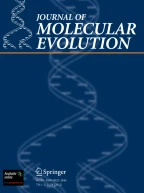Abstract.
Theories of the origin of life have proposed hypotheses to link inanimate to animate matter. The theory proposed here derived the crucial stages in the origin of animate matter directly from the basic properties of inanimate matter. It asked what were the general characteristics of the link, rather than what might have been its chemical details. Life and its origin are shown to be one continuous physicochemical process of replication, random variation, and natural selection. Since life exists here and now, animate properties must have been initiated in the past somewhere. According to the theory, life originated from an as yet unknown elementary autocatalyst which occurred spontaneously, then replicated autocatalytically. As it multiplied to macroscopic abundance, its replicas gradually exhausted their reactants. Random chemical drift initiated diversity among autocatalysts. Diversity led to competition. Competition and depletion of reactants slowed down the rates of net replication of the autocatalysts. Some reached negative rates and became extinct, while those which stayed positive ``survived.'' Thus chemical natural selection appeared, the first step in the transition from inanimate to animate matter. It initiated the first animate property, fitness, i.e., the capacity to adapt to the environment and to survive. As the environment was depleted of reactants, it was enriched with sequels—namely, with decomposition products and all other products which accompany autocatalysis. The changing environment exerted a selective pressure on autocatalysts to replace dwindling reactants by accumulating sequels. Sequels that were incorporated into the autocatalytic process became internal components of complex autocatalytic systems. Primitive forms of metabolism and organization were thus initiated. They evolved further by the same mechanism to ever higher levels of complexity, such as homochirality (handedness) and membranal enclosure. Subsequent evolution by the same mechanism generated cellular metabolism, cell division, information carriers, and a genetic code. Theories of self-organization without natural selection are refuted.
Similar content being viewed by others
References
Bernal JD (1967) The origin of life. Weidenfeld & Nicholson, London
Boehler C, Nielson PE, Orgel LE (1995) Template switching between PNA and RNA oligonucleotides. Nature 376:578–581
Bonner WA (1995) Chirality and life. Orig Life Evol Biosph 25:175–190
Cairns-Smith A (1982) Genetic takeover and the mineral origin of life. Cambridge University Press, London
Chapman KB, Szostak JW (1994) In vitro selection of catalytic RNAs. Curr Opin Struct Biol 4:618–622
Crick FHC (1968) The origin of the genetic code. J Mol Biol 38:367–379
Dawkins R (1982) The extended phenotype. Freeman, Oxford, p 181
de Duve C (1991) Blueprint for a cell: the nature and origin of life. Neil Patterson, Burlington, NC
Dover GA (1993) On the edge. Nature 365:705–706
Dyson FJ (1985) Origins of life. Cambridge University Press, London
Eigen M (1971) Self-organization of matter and the evolution of biological macromolecules. Naturwissenschaften 58:465–523
Eigen M (1992) Steps toward life: a perspective on evolution. Oxford University Press, Oxford
Feng Q, Park TK, Rebek J Jr (1992) Crossover reactions between synthetic replicators yield active and inactive recombinants. Science 256:1179–1180
Fox SW (1988) The emergence of life. Basic Books, New York
Frank FC (1953) On spontaneous asymmetric synthesis. Biochem Biophys Acta 11:459–463
Green R, Szostak JW (1992) Selection of a ribosyme that functions as a superior template in a self-copying reaction. Science 258:1910–1915
Joyce GF (1989) RNA evolution and the origin of life. Nature 338:217–224
Joyce GF (1994) In vitro evolution of nucleic acids. Curr Opin Struct Biol 4:331–336
Kauffman SA (1986) Autocatalytic sets of proteins. J Theor Biol 119:1–24
Kauffman SA (1993) The origins of order: self-organization and selection in evolution. Oxford University Press, Oxford
Li T, Nicolaou KC (1994) Chemical replication of palindromic duplex DNA. Nature 369:218–221
Lifson S (1987) Chemical selection, diversity, teleonomy and the second law of thermodynamics, reflections on Eigen’s theory of selforganization of matter. Biophys Chem 26:303–311
Miller SL (1955) Production of some organic compounds under possible primitive earth conditions. J Am Chem Soc 77:2351–2361
Oparin AI (1957) The origin of life on earth. Oliver & Boyd, Edinburgh
Orgel LE (1992) Molecular replication. Nature 358:203–209
Orgel LE (1995) Unnatural selection in chemical systems. Acc Chem Res 28:109–118
Rebek J Jr (1994) A template for life. Chem Br 30:286–290
Shapiro R (1986) Origins: a skeptic’s guide to the creation of life on earth. Summit, New York
Sievers D, von Kiedrovsky G (1994) Self-replication of complementary nucleotide-based oligomers. Nature 369:221–224
Szathmary E (1991) Simple growth laws and selection consequences. Trends Ecol Evol 6:366–370
Waechtershaeuser G (1992) Groundworks for an evolutionary biochemistry: the iron-sulfur world. Prog Biophys Mol Biol 58:85–201
Wilson C, Szostak JW (1995) In vitro evolution of a self-alkylating ribosyme. Nature 374:777–782
Author information
Authors and Affiliations
Additional information
Received: 29 March 1996 / Accepted: 30 May 1996
Rights and permissions
About this article
Cite this article
Lifson, S. On the Crucial Stages in the Origin of Animate Matter. J Mol Evol 44, 1–8 (1997). https://doi.org/10.1007/PL00006115
Published:
Issue Date:
DOI: https://doi.org/10.1007/PL00006115
